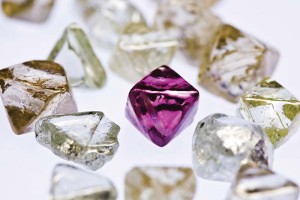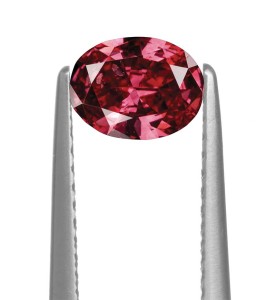Background

Coloured diamonds were not talked about much in the 1960s; auction houses only listed a diamond as ‘fancy,’ ‘canary,’ or ‘cinnamon,’ with a black and white photograph shown in catalogues and very little other information included. In the late 1980s, the perception surrounding fancy-coloured diamonds began to change when the .95-carat ‘Hancock Red’ sold for almost”¨ $1 million US per carat. This also seems to be the time when prices began to rise, as demand for rare colours increased and media became more interested in these unknown beauties. At the same time, the Argyle mine began producing steady amounts of pink diamonds in all sizes, along with the more common brown diamond. The new mine supplied enough volume to make pavé-setting pink diamonds feasible.
By the 1990s, designer Ralph Esmerian had introduced pink diamonds to the U.S. market. It was around this time the 5.11-carat ‘Moussaieff Red Diamond’ was found in a river in Brazil and later sold to a collector for $2 million US per carat. Imagine it—$10 million US for one gram of carbon that nature created over millions of years through high pressure and temperature into the rarest colour of all, the fancy red diamond.
The advent of the Internet has allowed a wider audience to come to know fancy-coloured diamonds; dealers with access to large and important stones actually have a waiting list of clients keen for specific colours and sizes. The celebrity factor also helps.
Long prized for their rarity and beauty, coloured diamonds are hot-ticket items today, thanks in part to actresses such as Jessica Biel, who received a pink diamond engagement ring from Justin Timberlake. And who could forget the 6.10-carat pink sparkler Jennifer Lopez received from Ben Affleck.
Aside from adornment, however, there’s another reason for their popularity: investment. While fancy-coloured diamonds appear attractive among investors, great caution is required when purchasing them for this purpose. As with all investments, buying low, or in this case, farther up the supply chain, is key to realizing a return. Also, rarity is a significant factor in making a worthwhile investment.
Describing and appreciating colour

After brown diamonds, yellows are the most common of the fancies, but still rarer than colourless diamonds of the same clarity. Larger quantities of light yellow diamonds were found in the late 1800s in South Africa’s Cape province. Since then, the term ‘cape’ has been used to describe yellows that have ‘cape serious’ spectra (415, 452, 478 nm peaks) regardless of origin. The rarest yellow diamonds are highly saturated and show pure yellow hues. In the 1950s, the industry referred to these colours as ‘canary,’ but in today’s market, they are most commonly referred to as ‘intense’ and ‘vivid’ yellow. Some strong (i.e. intense and vivid) canaries may also have an orange modifier. Greenish yellow diamonds of natural colour are also rare, along with deep yellow diamonds with brownish, greyish, orangey, or olivish modifiers, which are also coveted by collectors and investors. Compared to other fancy colours, yellow diamonds are more abundant in nature, although their value jumps significantly when the colour is stronger than the ‘Z’ master stone.
Grading colour of fancy diamonds is perhaps the most difficult of the four Cs to determine. GIA uses six categories to describe their grades: ‘fancy light,’ ‘fancy,’ ‘fancy intense,’ ‘fancy dark,’ ‘fancy deep,’ and ‘fancy vivid yellow.’
Although this system is most widely used, grading colour remains a subjective exercise and open to further discussion. For instance, another system exists to describe the different shades of yellow diamonds, using terms such as, ‘canary,’ ‘chartreuse,’ ‘golden,’ ‘lemon,’ and ‘straw.’ These common colour names and many others are defined in the glossary section of Stephen Hofer’s book, Collecting and Classifying Coloured Diamonds.
According to Hofer, the problem with colour grading is the common belief that it should be straightforward, black and white so to speak. After all, how hard can it be to determine what colour something is?
“In fact, the colour grade is only a quick and simple way to denote the hue, lightness, and saturation of a coloured diamond by lumping them into a limited range of 27 colours (hues and modifiers), and a limited range of six colour grades,” he says. “The problem begins with the diamond industry’s reliance on subjective colour grading procedures, which can only result in confusion and errors in describing colour to others.”
If the diamond industry gently moved in the direction of using instrumental methods like spectrometers to measure colour in diamonds, and then use this numerical colour data as a valid starting point to begin a more accurate and precise method to assign colour, we would not only create a better understanding of colour, but introduce wholesalers and retailers to a greater range of colour in diamonds.
Colour in diamonds is 3-D, defined by saturation”¨ (i.e. X on the scale, indicating ‘fancy’), tone (i.e. Y, which represents how light or dark it is), and hue (i.e. Z, meaning general colour [e.g. yellow]). Hence, the colour grade ‘fancy light yellow,’ for example. Having exact XYZ co-ordinates can help determine grade objectively, and therefore, assign it more accurately.
If diamond cutters incorporated this 3-D concept, they would likely develop new ways of cutting diamonds yielding more varieties of colour that may appeal to consumers looking for a wider range of options.





